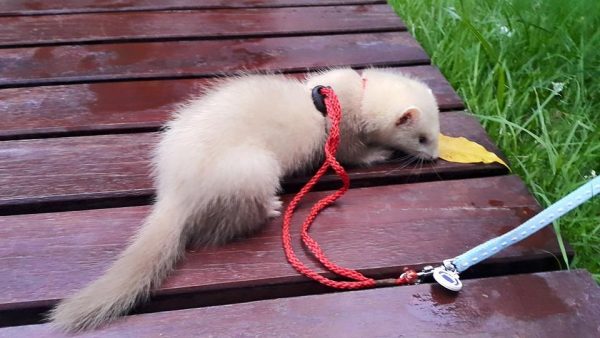Champagne Ferrets are among the more light-colored ferrets and they’re a delight to have as pets. They still have a brown color but it’s a lot lighter than other ferrets. This is why many ferret owners will call this a diluted chocolate shade.

They’re not different at all than other ferrets, except for the way their fur is colored. There are up to 8 main types of coats found on ferrets and up to 12 patterns. This makes them quite different-looking from one another and many people have specific preferences.
What do Champagne Ferrets Look Like?
Champagne Ferrets have a very light brown coat that resembles the color of champagne. Not all Champagne Ferrets look exactly the same as some can have the feet a bit darker, others the tail, some have darker backs, etc. But to be considered a Champagne Ferret it has to have a much lighter color than the usual ferrets.
When it comes to the undercoat, it can be either white or cream. If the undercoat is cream, you will hardly tell the difference between it and the top coat as they’re almost the same color. But if it’s white, it will offer a nice look and make the ferret even more adorable-looking.
The eyes of these ferrets differ quite a lot from ferret to ferret. Some of them could have brown eyes, others pink eyes, and some might even have burgundy (dark red) eyes. More than that, they can also have rings of different colors around them.
Champagne Ferrets are among the most available ones as they’re not very rare. This is also part of the 8 main color types of ferrets. The other 7 are albino, black, black sable, dark-eyed white, blaze, chocolate, and cinnamon. The cinnamon ferrets are the rarest in the world.
Grooming Ferret Coats – Brushing and Bathing
Ferrets have a natural smell that can be extremely unpleasant for any ferret owner. This is why they’re neutered and having their anal glands removed before they get to the owner. But this is not enough to get rid of all the musky smell, although it reduces up to 90% of it.
The 10% that remains can still bother many ferret owners and most of them struggle with keeping the smell under control. At this point, all you can do is take grooming and cage cleaning very seriously as it can help reduce the smell even more. And what odor remains, you just have to get used to it.
Bathing only gets rid of the smell for literally a few moments. Once the ferret is dry, its body will start making more oil to help the skin and the coat keep its usual gloss. These oils are the ones that smell musky and they’re a necessity to ferrets as their skin is extremely fragile and sensitive.
You can bathe a ferret once a month but more than that can be harmful. And remember to use a ferret shampoo and to rinse it very well so the skin won’t get irritated because of leftover dry shampoo.
Brushing will also help avoid getting the oil stuck in entangled hair, which can make the ferret smell worse. A short-bristled brush that is made for ferrets is all you need. But you’ll have to move fast as your ferret can get very bored within the first few minutes.
More than that, you can disinfect your ferret’s cage every single week and change everything with clean and fresh-smelling items. This includes getting all the sleeping beds and toys to the washing machine and get new ones.
What needs to be washed manually can be disinfected with ferret-safe disinfectant, including the food and water bowl, tubes, various toys, the litter box, the cage itself, etc. It’s a little bit of work every week but it makes a huge difference in your ferret’s smell. And after a while, the cleaning time you need will go down by a lot once you got the routine down.
There are also odor neutralizers that can work pretty well on some ferrets. It needs to be sprayed on a cloth and then use said cloth to rub it onto the fur. You should never stray any type of product directly on your ferret.
Frequently Asked Questions:
What are the most common types of ferret coats?
The most common types of ferret coats are Albino, Black Sable, Black, Dark-Eyed White, Blaze, Champagne, Chocolate, and Cinnamon.
Are Champagne Ferrets difficult to care for?
Champagne Ferrets are not hard to maintain as they’re naturally clean creatures that like to keep themselves clean. The grooming sessions are very short and some ferrets even love taking baths.
